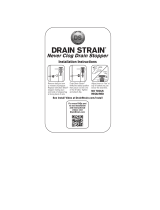Delta 1200 Technical Manual 07610-003-62-15 C
Issued: 10-27-2008 Revised: N/A
SECTION 2: INSTALLATION/OPERATION INSTRUCTIONS
ELECTRICAL CONNECTIONS
trap is required by code, it should have a flow capacity of 5
gallons per minute.
WATER SUPPLY CONNECTION: Ensure that you have read
the section entitled “PLUMBING THE DISHMACHINE” above
before proceeding. Cold water supply must be a minimum of
70°F with a capacity of 180 gallons per hour at 8-12 PSI flow
to the glasswasher. Hot water supply must be a minimum of
130°F with a capacity of 10 gallons per hour at 20±5 PSI flow
pressure. Incoming hot and cold water service connection
(supplied by customer) must be a 1/2” pipe size minimum with
shut off valve. Install the water supply line (1/2” pipe size min-
imum) to the dishmachine using copper pipe. It is recom-
mended that a water shut-off valve be installed in the water
line between the main supply and the machine to allow access
for service.
In areas where the water pressure fluctuates or is greater than
the recommended pressure, it is suggested that a water pres-
sure regulator be installed.
Do not confuse static pressure with flow pressure. Static pres-
sure is the line pressure in a “no flow” condition (all valves and
services are closed). Flow pressure is the pressure in the fill
line when the fill valve is opened during the cycle.
It is also recommended that shock absorbers (not supplied
with the Delta 1200 units) be installed in the incoming water
lines. This prevents line hammer (hydraulic shock), induced
by the solenoid valves as they operate, from causing damage
to the equipment.
PLUMBING CHECK: Slowly turn on the water supply to the
machine after the incoming fill line and the drain line have
been installed. Check for any leaks and repair as required. All
leaks must be repaired prior to placing the machine in opera-
tion.
ELECTRICAL POWER CONNECTION: Electrical and
grounding connections must comply with the applicable por-
tions of the National Electrical Code ANSI/NFPA 70 (latest edi-
tion) and/or other electrical codes. Disconnect electrical
power supply and place a tag at the disconnect switch to indi-
cate that you are working on the circuit.
The dishmachine data plate is located on the right side of the
door. Refer to the data plate for machine operating require-
ments, machine voltage, total amperage load and serial num-
ber.
To install the incoming power lines, remove the electrical box
cover. This will require taking a phillipshead screwdriver and
removing the two (2) screws at the bottom corners and lift up
and off. Let the cover rest against the plumbing assembly.
Install conduit from the underside of machine to hole in rear of
electrical box below terminal block and ground lug. Install the
service wires (L1 & L2) to the appropriate terminals as they
are marked on the terminal block. Install the grounding wire
into the lug provided. Tighten the connections. It is recom-
mended that “DE-OX” or another similar anti-oxidation agent
be used on all power connections.
VOLTAGE CHECK: Ensure that the power switch is in the
OFF position and apply power to the dishmachine. Check the
incoming power at the terminal block and ensure it corre-
sponds to the voltage listed on the data plate. If not, contact a
qualified service agency to examine the problem. Do not run
the dishmachine if the voltage is too high or too low. Shut off
the service breaker and mark it as being for the dishmachine.
Advise all proper personnel of any problems and of the loca-
tion of the service breaker. Replace the electrical box cover
and tighten down the screws.
6
Terminal Block
Ground Lug





























